Bulletin – December 2019 Global Economy How Do Global Financial Conditions Affect Australia?
- Download 748KB

Abstract
Australia is closely integrated with global capital markets. This integration has been of benefit to the economy, but also means that Australian financial conditions are influenced by developments abroad. The flexible exchange rate regime partially insulates the economy from global financial conditions. In particular, that flexibility means that monetary policy in Australia does not need to move in lock step with policies of the major central banks. However, to meet its objectives for employment and growth, the Reserve Bank can choose to offset pressure on the exchange rate from shifts in foreign monetary policies. Indeed, for much of the past decade or so, forces underpinning the structural decline in global risk-free rates have placed downward pressure on interest rates offshore and in Australia. International investors’ willingness to take risk also has an important bearing on domestic financial conditions.
Introduction
The Australian economy has had an open capital account ever since barriers to cross-border capital flows were dismantled during the period of financial reform in the late 1970s and 1980s. Australians are free to borrow and invest in financial assets abroad, and foreigners can do likewise in Australian markets, as is the case across many advanced economies (Figure 1). In the decades since the Australian economy was opened, global capital markets have grown substantially. For example, cross-border assets and liabilities globally have expanded five-fold relative to the global economy in that time. Against that backdrop, there has been significant debate in international circles as to whether financial conditions in open economies such as Australia are determined foremost by developments in the global financial centres.[1]

This article lays out the key contours of Australia's financial linkages with the rest of the world and their implications. The first part sets the scene, sketching out Australia's financial ties with other economies and how these are changing. Having discussed the nature of these links, the remainder of the article examines how Australia is affected by shifts in foreign financial conditions. Three major forces in international markets are (i) monetary policy settings of the major central banks, which shift interest rates over the cycle around longer-run trends, (ii) structural factors affecting those longer-run trends in interest rates, and (iii) swings in global investors' willingness to bear risk. These forces can have differing effects on Australia through bond markets, the banking system, capital flows and the exchange rate.
Australia's Integration with Global Capital Markets
Australia has benefited from being a net importer of foreign capital
Australia has long raised funding abroad. The economy has been a net importer of financial capital from the rest of the world for most of its modern history, recorded as deficits on the current account (Graph 1). That has reflected a surplus of attractive investment opportunities in excess of Australia's capacity to fund those via domestic savings. This external funding has been used to build productive assets, thus supporting employment and productivity, and as a result the Australian economy has benefited.[2]
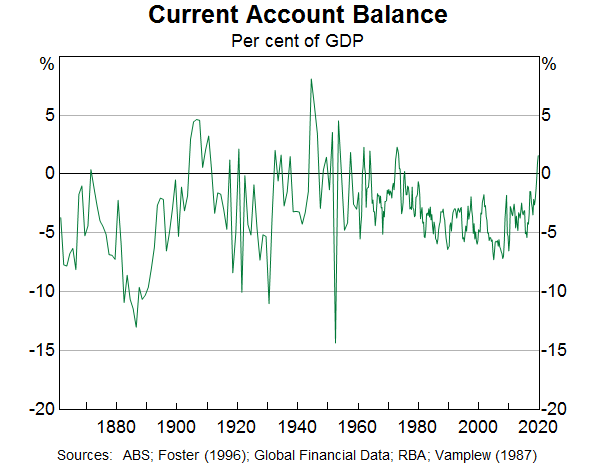
This long history of importing capital means that the economy has a net liability to the rest of the world. The size of this liability relative to GDP is not dramatically different to that seen since the 1990s (Graph 2).
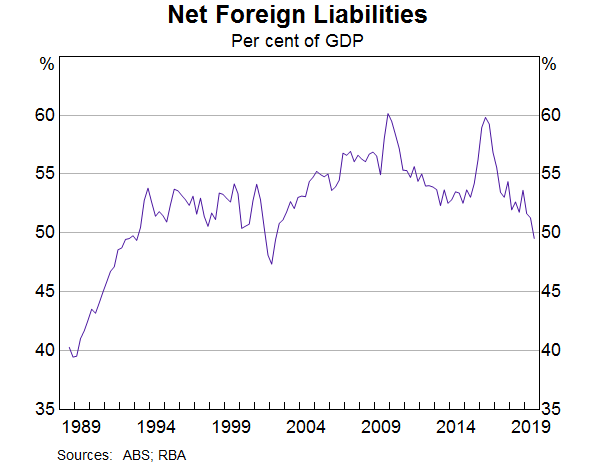
In recent years, these net inflows of capital have declined and even reversed. In 2019, there have been net capital outflows for the first time since the 1970s – that is, a current account surplus. In large part, this shift reflects the end of the mining investment boom, as well as a decline in net borrowing by the government sector.[3] The mining boom saw high levels of investment that drew upon increased funding from abroad, despite reasonable levels of domestic saving (Graph 3). As investment has declined as a share of GDP in recent years, the economy's net need for external capital has also fallen. As a result, net foreign liabilities have declined to their lowest levels since the early 2000s, relative to the size of the economy.
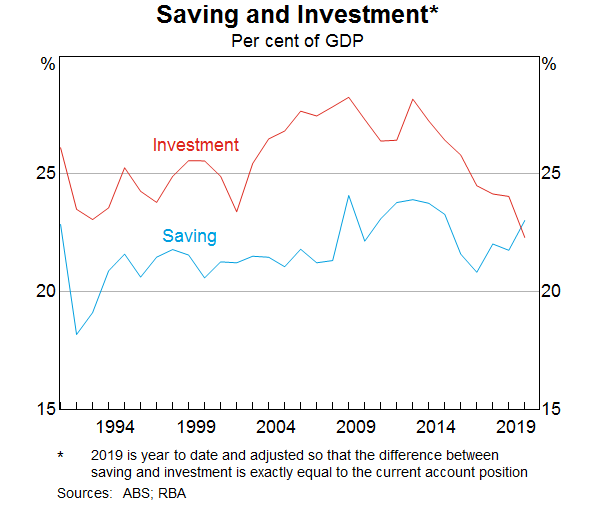
The economy has continued to become more ‘integrated’ with global capital markets
While net capital inflows have declined markedly since the end of the mining boom, the economy has continued to become more integrated with the global financial system via a growing stock of gross foreign assets and liabilities. Over the past decade, the gross liabilities that Australians owe to the rest of the world and the gross assets that Australians own abroad have both risen by roughly 50 percentage points of GDP (with assets having risen by more than liabilities) (Graph 4).
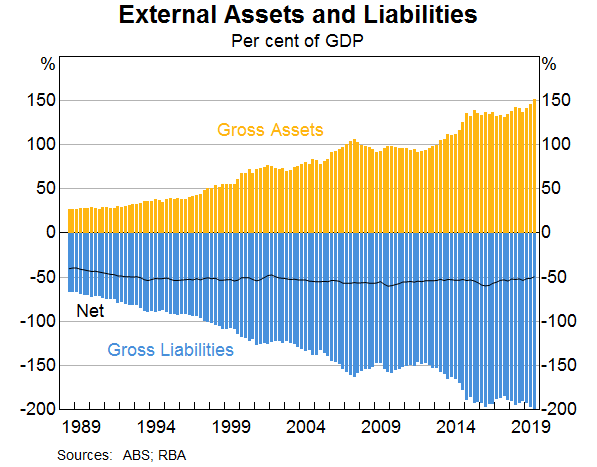
This integration is beneficial for a number of reasons. Foreign liabilities reflect Australians tapping into the deep pool of international capital to obtain funding at favourable cost. For example, Australian banks find it beneficial to raise a portion of their debt in offshore markets to access a much wider investor base than is available at home. At the same time, Australian investors, including Australia's large and growing superannuation sector, can purchase foreign assets to diversify their portfolios. These gross positions have expanded markedly since the crisis, amid strong foreign demand to invest in Australia as well as growth in international assets of the superannuation sector.[4]
Australia's financial ties are strongest with other advanced economies, in contrast to our trade links
Australia's financial linkages remain strongest with advanced economies. For example, other advanced economies account for more than 90 per cent of Australia's foreign liabilities and a similar share of foreign assets (Graph 5, left panel).[5]
In turn, Australia's direct financial links with emerging economies remain modest, despite having grown somewhat. Looking at China in particular, capital has flowed more freely across China's borders over the past decade, at times making up a material share of net and gross capital flows to Australia.[6] But the stock of these investments accounts for only 2 per cent of foreign investment in Australia, and 5 per cent including investment from Hong Kong. That stands in contrast to our trade relationships, which are more closely tied to emerging economies; for example, China comprises nearly one-third of Australia's exports (Graph 5, right panel).
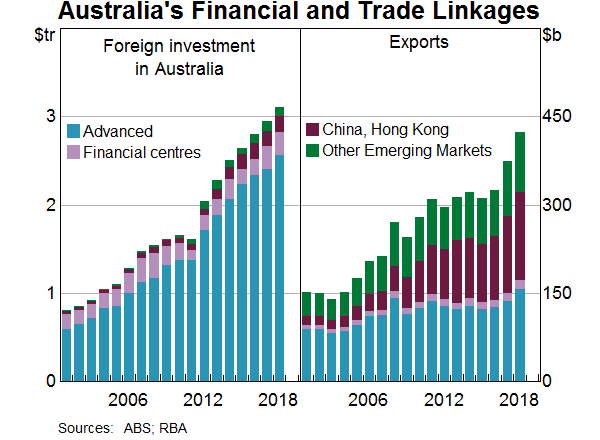
More generally, while emerging economies make up a large and growing share of global output, they are much less integrated with global capital markets than advanced economies. Emerging economies are more likely to have maintained constraints on capital flows, and are often considered to present greater risks to foreign investors. Indeed, a key reason that Australia's financial links have not yet deepened further with China is that it remains fairly closed financially. Mainland China's gross external assets and liabilities sum to around 100 per cent of GDP, compared to 350 per cent for Australia.
Key Dimensions of Global Financial Conditions
Openness also means the economy is affected by international financial conditions
While Australia has benefited from being open to global capital markets, this also means that the economy is exposed to shifts in global financial conditions. Because Australia imports capital mainly from the other major advanced economies, which themselves tend to be financially integrated with one another, shifts in financial conditions in those economies are potentially of greatest importance. That said, Australia's large trade links with China and other emerging economies mean that developments in these economies can still affect financial markets in Australia (as discussed below).
In the first instance, Australian firms that are raising funding offshore are impacted by a change in the cost and/or availability of funding in those markets. Another channel is via the effect of offshore conditions upon Australian markets, because capital can move relatively freely across borders. In essence, Australia's openness to global financial markets means that prospective returns on Australian assets will tend to move towards global returns, when expressed in common currency terms (and adjusted for risk). For example, a decline in interest rates abroad would, all else being equal, see capital inflows, which in turn would place downward pressure on returns to Australian assets. That might then lead to downward pressure on domestic interest rates, thereby easing financial conditions. Or it might induce an appreciation of the Australian dollar (making Australian assets more ‘expensive’), thereby ‘insulating’ domestic financial markets from the easing in interest rates offshore.
The major global forces are monetary policies, structural forces and risk aversion
To understand more precisely how financial conditions offshore influence those in Australia, it is useful to consider three key forces that determine the cost and availability of finance in the major advanced economies:
- Monetary policies set by the major central banks, which determine ‘risk-free’ interest rates. These policies shift interest rates on a cyclical basis, but do so around long-term structural trends.
- Structural factors which affect those longer-run trends in risk-free interest rates.
- The global appetite for risk, as reflected in risk premiums (the additional return investors require above the risk-free rate for taking on investment risks) and the general availability of funding in major financial centres.
The following three sections consider these forces in turn. In short, the flexible exchange rate, while an essential means of adjustment, does not perfectly ‘insulate’ against all financial developments abroad. Rather, how conditions transmit depends on the nature of the change in global financial conditions.
‘Cyclical’ Shifts in Foreign Monetary Policy
Australian interest rates do not move mechanically with foreign monetary policies
Changes in monetary policies by the major central banks do not have a mechanical bearing on the cost of borrowing for Australians. There are two key reasons for this. First, Australian entities that raise funding in global markets tend to borrow either in Australian dollars directly or in foreign currencies but hedge back into Australian dollars. As a result, the cost for Australians of funding in the United States, for example, is effectively anchored to Australian dollar rather than US dollar risk-free interest rates.[7]
Second, the Reserve Bank does not need to move in lock step with foreign central banks when setting the cash rate, because the exchange rate floats. As policy rates in Australia shift relative to those abroad and capital seeks to flow towards markets offering higher (risk-adjusted) returns, the exchange rate will tend to adjust. In contrast, in economies where the exchange rate is fixed, or nearly so, central banks do need to mechanically match the policy actions of other central banks to discourage such movements of capital.
As a result, the cash rate can be adjusted as appropriate for domestic conditions. For example, during the global financial crisis, the Bank did not need to reduce policy rates to as low a level as central banks abroad (Graph 6). This reflected the fact that the Australian economy was relatively supported by the general resilience of our financial system (at a time when financial systems in the large advanced economies were under considerable stress) and that the exchange rate was responsive to sharp movements lower and then higher in commodity prices over this period.[8]
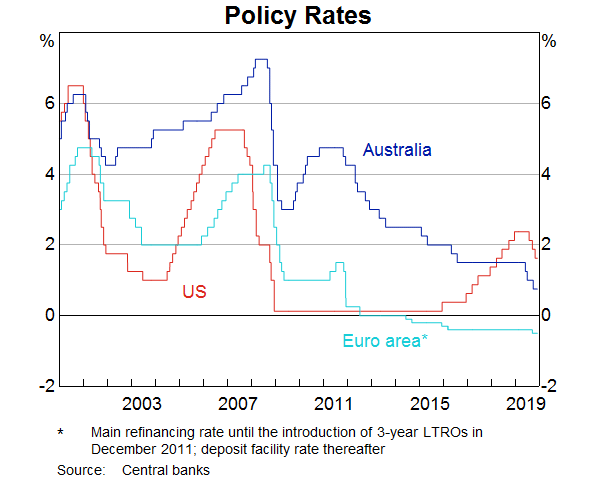
But foreign monetary policy has other influences
Changes in foreign monetary policy can, however, influence financial conditions in Australia through other channels. As noted, an easing of foreign monetary policy tends to place upward pressure on the Australian dollar.[9] All else being equal, a decline in foreign interest rates relative to Australia makes our assets more attractive for globally mobile capital. Such an appreciation is contractionary for the economy, as it makes domestic producers less competitive internationally, and so is akin to a tightening of financial conditions. Accordingly, to meet its objectives for employment and growth, the Bank can choose to offset that pressure by lowering the cash rate.
Of late, easier policy abroad has placed some upward pressure on the exchange rate, but that has been more than offset by the easier stance of domestic monetary policy. Yields on two-year Australian Government bonds, which are heavily influenced by expected monetary policy, are now around their lowest level relative to the other major economies in the past 20 years (Graph 7). This has contributed to the Australian dollar being at the lower end of its range over recent times, a helpful development in the context of the outlook for domestic growth and inflation.
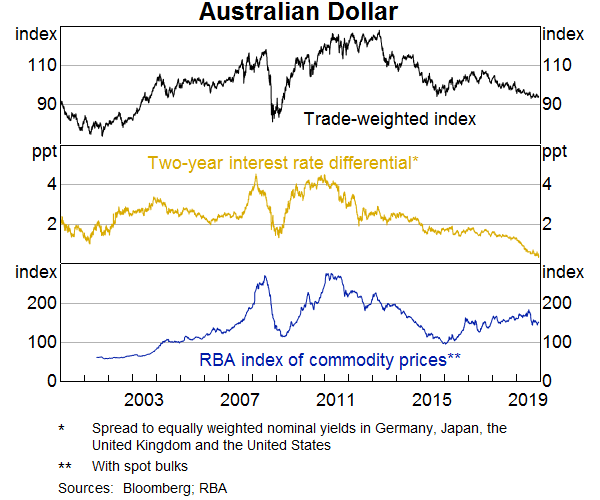
Finally, easier monetary policy abroad can affect global risk premiums, in an offsetting direction to the effect on exchange rates. For example, easier monetary policies are likely to be pursued in order to help offset shocks that would otherwise weaken growth and push up risk premiums. The effect of global risk premiums on Australian borrowers is discussed in more detail below.[10]
‘Structural’ Shifts in Global Risk-free Interest Rates
There has been a secular decline in global risk-free interest rates …
Central banks set monetary policy in response not only to the business cycle, but also underlying structural shifts in prevailing, ‘normal’ level of interest rates that are appropriate for their economies over the medium term. Over a long time span, all central banks are being affected by similar structural factors that are putting downward pressure on interest rates.
In particular, there has been a broad-based decline in risk-free rates in advanced economies over the past two or so decades. That downtrend is clearly evident in longer-term government bond yields (Graph 8). These yields are heavily influenced by expectations for average policy settings over the years ahead and so look through cyclical swings in countries' policy rates driven by the business cycle. Long-term bond yields have declined steadily across a number of economies not only in nominal terms, but also in ‘real’ terms (i.e. after adjusting for the decline in inflation from high levels in some economies).
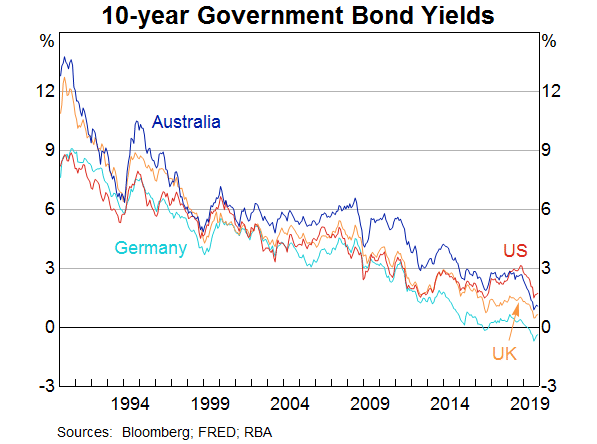
This ongoing downward trend reflects longer-term structural trends globally, which are seeing an increased appetite to save and reduced appetite to invest (at any given interest rate). Such factors include demographic trends, the integration of high-saving Asian economies into the global economy, the legacy of high levels of borrowing in the past, elevated levels of uncertainty and lower rates of potential economic growth.[11]
… which has influenced risk-free interest rates in Australia
These same trends have affected interest rates in Australia, reflecting our position as a small open economy. Australian monetary policy cannot influence the factors affecting global savings and investment behaviour, which are driving down global interest rates. But if the policy rate in Australia had been maintained in the face of a trend decline in global interest rates, the Australian dollar would have appreciated noticeably, which would have moved the economy away from the Bank's goals for domestic growth and inflation. Hence, monetary policy in Australia was eased at least partly in response to the effect that a persistent decline in global interest rates would otherwise have had on the Australian dollar (Lowe 2019a, 2019b). In addition, there has been a range of headwinds to growth and inflation in Australia and abroad, which has seen central banks respond in a similar fashion.
This situation is not unique to Australia. For example, one recent analysis has shown that 60 per cent of the movement in risk-free rates in advanced, open economies over the past few decades is explained by structural shifts, which in turn have a large global component (Jordá and Taylor 2019).
International Risk Aversion
The global appetite for risk also influences global financial conditions
Separate from policy rates, financial conditions in international markets are heavily influenced by the willingness of investors to take on risks. When investors perceive risks to have risen (either globally or in a particular economy), they will require a higher return to compensate for that risk – that is, a higher premium relative to risk-free rates. They may also become less willing to lend in as large a quantity as previously, and even curtail lending to very risky borrowers.
How might a rise in international risk aversion spill over to Australia?
- First, Australian banks and corporations would face higher costs of funding in international markets, and at the extreme they might be unable to raise as much funding. While borrowers can hedge against movements in risk-free rates abroad (and exchange rates), these hedges do not insulate them from risk premiums in international funding markets.
- Second, Australian entities might attempt to replace that funding abroad by raising more equity or debt in Australian markets. That additional demand will tend to increase the cost of those funds in the domestic markets, which are not as deep as those offshore. That would contribute to a rise in the cost of borrowing in Australia, over and above the domestic risk-free rate.
Australian risk premiums move with those in advanced economies, even with the flexible exchange rate
Reflecting these links, during periods in which international investors become more concerned about risks, there tends also to be a rise in risk premiums in Australia. For example, measures of risk premiums in Australian markets for bonds, equities and short-term money move very closely with those in the United States (Graph 9).
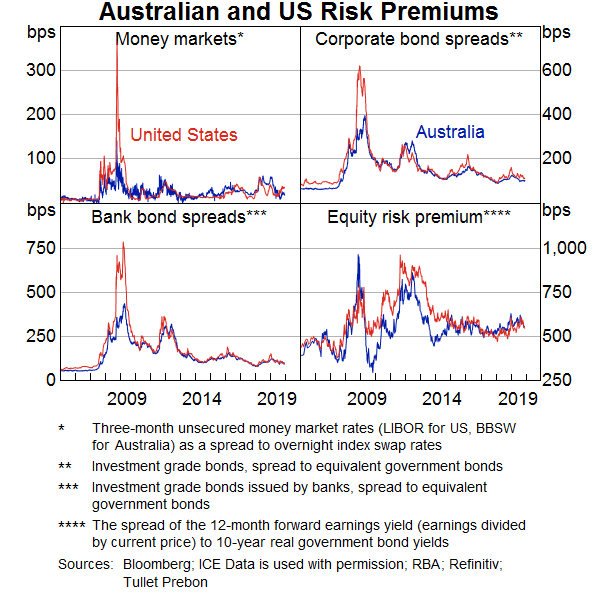
Accordingly, having a flexible exchange rate does not fully insulate the economy against these swings in international risk aversion. Again, this experience is not unique to Australia. An extensive literature has shown that these shifts in risk aversion spill across a wide range of economies, including others with flexible exchange rates.[12]
Australian asset prices have not tended to move as closely with those in China, though this is shifting
The effect of financial links is seen in the fact that Australian and US risk premiums move so closely. Indeed, risk premiums in Australia have moved more tightly with those in the United States than would be expected based purely on the fact that the Australian and US economies are at times in a similar phase of the business cycle.
The flipside is that Australian asset prices do not move as closely with Chinese asset prices as they do with US asset prices, despite our deep trade linkages with China (Graph 10). That said, developments in China still matter for financial conditions in Australia, via the ‘confidence effects’ they have on Australian financial prices. Indeed, these appear to have strengthened over time. This is seen in the rising – even if still somewhat low – correlation between Australian and Chinese risk premiums (as well as exchange rates and risk-free rates) (Graph 11).[13] As China becomes more interconnected with the global financial system these links could be expected to strengthen further.
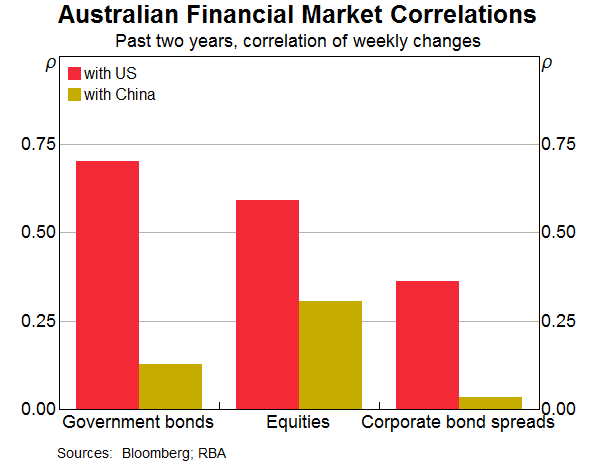
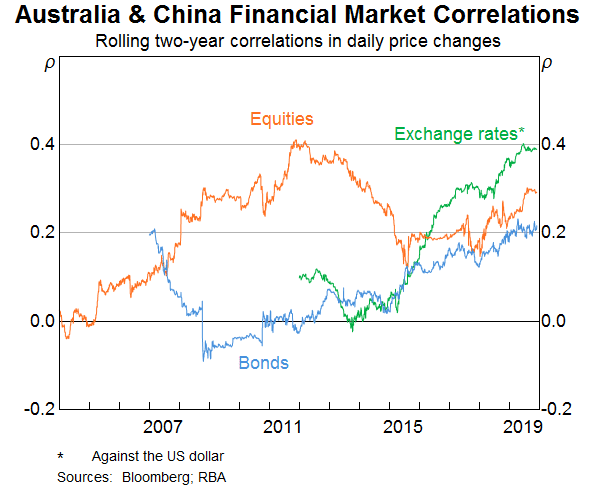
In the extreme, funding may also become more difficult to obtain in international markets
Of late, risk aversion in international financial markets has been low, as indicated by narrow risk premiums across a range of asset classes. However, history has shown that lengthy periods of benign financing conditions can sometimes be followed by abrupt increases in risk aversion, although specific triggers for these types of episodes are difficult to predict. For a very short period (about a month) during the height of the global financial crisis Australian banks did not access funding markets offshore.[14] Notwithstanding that extreme but short-lived episode, there are a number of factors that help to protect Australia during bouts of severe risk aversion.[15]
In part reflecting those mitigants, the sizeable risk premium that financial markets applied on Australian assets for much of the 1980s and 1990s compared to our international peers has since diminished. That can be seen in comparing real (inflation-adjusted) bond yields in Australia to other major advanced economies over the past four decades (Graph 12).[16]
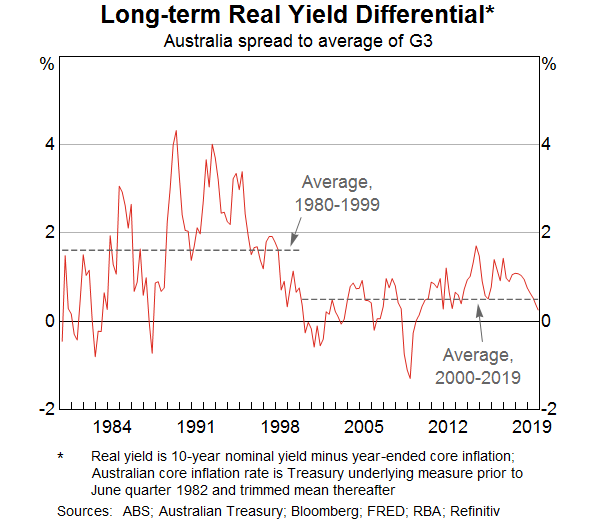
The flexible exchange rate still provides an important shock absorber
Periods of increased risk aversion are typically associated with a depreciation of the Australian dollar (partly because commodity prices also tend to decline). While such a depreciation might not completely insulate against global risk aversion, it would still adjust to a significant extent for any decline in international demand for Australian dollar assets.
Indeed, an important feature of Australia's economy is that it is able to withstand, and moreover can be aided by, sharp depreciations of the Australian dollar. A depreciation boosts net trade by making Australian producers more internationally competitive (the ‘trade channel’). In addition, a depreciation of the Australian dollar does not hurt Australians that are funding abroad, including the Australian banks. That is because they tend to raise funds in Australian dollars or hedge the exchange rate exposures associated with borrowing in foreign currencies. As a result, Australians' offshore borrowing needs actually decline (in foreign currency terms) when the exchange rate depreciates. Moreover, Australians receive net inflows from counterparties on their currency hedges when the Australian dollar depreciates; in the global financial crisis, these inflows were sizeable.[17]
In contrast, for countries where funding is primarily in foreign currency and unhedged, a depreciation requires borrowers to use more local currency to repay existing offshore debts. That can impair the balance sheets of banks and firms who have borrowed abroad, resulting in an adverse ‘financial channel’ that counteracts the benefits of the trade channel following a depreciation.
Australians can issue liabilities in their own currency because foreigners are comfortable holding exposure to the Australian dollar. In part, that has reflected favourable risk-adjusted returns and diversification benefits. But it has also reflected other factors: the Australian dollar is liquid, convertible and does not pose risks of debasement thanks to a credible inflation target. Indeed, the Australian dollar has remained the fifth most traded currency globally in recent years (Guo, Ranasinghe and Zhang 2019). International investments in Australian dollar assets are also made in the context of strong domestic legal protections.
Relatedly, a deep hedging market is important in ensuring that Australians can borrow abroad without being exposed to movements in the exchange rate (or foreign interest rates). The depth of this market is underpinned by a range of ‘natural’ counterparties that are looking to lend Australian dollars via hedging contracts. A substantial rise in hedging costs would increase the cost of raising funds offshore for many entities, while a disruption to the functioning of the swap market would impair the ability to roll over hedged foreign currency debt. That said, the fact that Australian borrowers tend to hedge the full maturity of their offshore debt, and primarily use these markets to fund Australian dollar (rather than foreign currency) assets, means that they are less exposed in the event that there is such a disruption.[18],[19]
Funding with equity and long-term debt reduces funding needs during such squeezes
Even with a depreciation of the exchange rate, Australian borrowers abroad could be affected by a drying-up of funding in global markets. The fact that net capital inflows are currently low (or indeed negative) would be of some help in such an event. Even so, these net flows can shift quickly as economic conditions change, and a lesson from earlier crises abroad is that gross as well as net funding needs are important when assessing how events abroad might transmit. For example, those banks or businesses that are overall borrowers in international markets may not be able to obtain funding provided by other Australians who are accumulating foreign assets (such foreign equities purchased by superannuation funds). This can impede their ability to obtain new funding on favourable terms, as well as make it more difficult for them to roll over existing debts as they mature.
However, much of Australia's gross offshore funding is in forms that do not need to be rolled over frequently, so are less vulnerable than otherwise to a sharp rise in investors' risk aversion. In particular, a large share of foreign liabilities are in the form of equity (about 40 per cent), which does not need to be rolled over in the way that debt does (Graph 13). For example, there have been large foreign equity investments in the mining sector in recent years, although equity funding was widely used even prior to the resources boom. Also, debt liabilities have been issued with longer-term maturities over recent years. Short-term debt – that which falls due within a year – has fallen from half of Australia's gross foreign debt in the early 2000s to about one-third today (Graph 14).
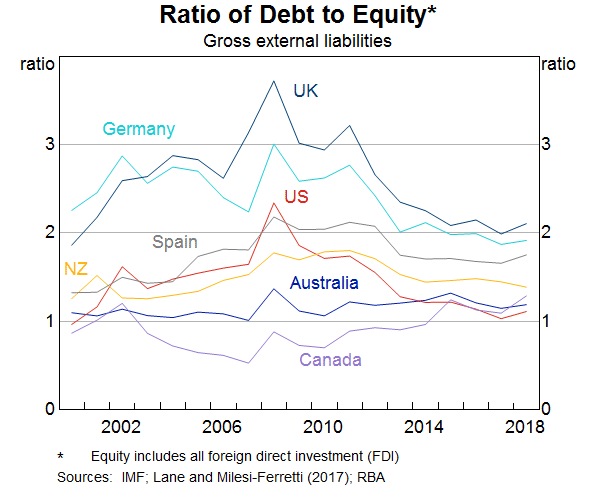
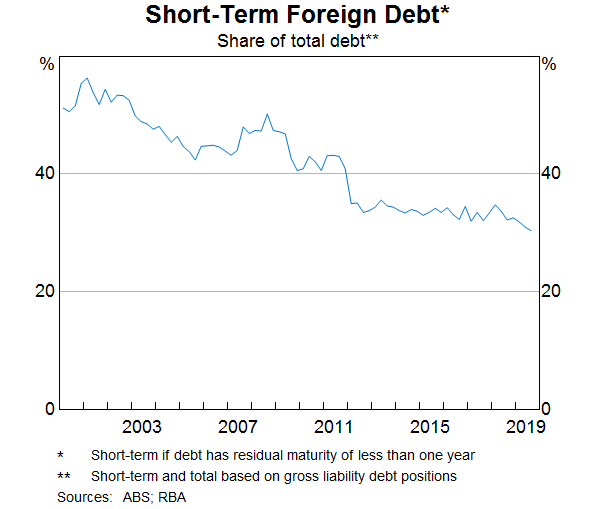
If the resources investment boom had instead been funded by short-term foreign debt, rather than equity, the external funding risks to that sector would now be much greater. A sharp fall in commodity prices amid weaker global growth could see investors quickly curtail their funding to mining companies given a weaker outlook for profits. In contrast, we might now see a fall in the value of equity owned by foreigners, but that does not pose a risk either to the cost or the volume of funding of the long-term assets in the sector.
And sound institutions helps the economy to weather bouts of severe risk aversion
History also shows that Australia's access to foreign markets is supported by a range of institutional features. In particular, investor confidence is supported by credible macroeconomic stabilisation policies as well as a resilient financial system, characterised by deep financial markets and well-capitalised financial institutions. The ability of the Australian banking system to withstand shocks has been strengthened since the financial crisis, with higher capital ratios, improved lending standards, and a shift to more stable forms of funding and increased holdings of liquid assets. Australia has maintained its high credit rating, even as many of its peers have been downgraded over the past decade. Indeed, foreign creditors have never suffered from any defaults on the debt of the Australian sovereign, which is true for only a small group of countries.
Conclusions
While the Australian economy has benefited greatly from being closely integrated with global capital markets, that openness means that the domestic economy is affected by shifts in global financial conditions. The flexible exchange rate regime partially insulates the economy from financial conditions abroad; monetary policy can attend to domestic conditions and does not need to move in lock step with cyclical shifts by the major central banks. However, other things being equal, a decline in policy rates abroad would tend to see global capital flow towards Australia, thereby contributing to an appreciation of the Australian dollar. To meet its objectives for employment and growth, the Bank can choose to offset that pressure by lowering the cash rate, and has broadly done so for much of the past decade or so as there has been a trend decline in risk-free interest rates across advanced economies for structural reasons. In the event of a sharp rise in investor risk aversion abroad, Australian borrowers would be affected, although a number of features of our financial system would help to mitigate those effects. These include the flexible exchange rate alongside the nature of our external financing, including the fact that Australians fund in Australian dollars or are well hedged.
Footnotes
The author is from International Department, and thanks David Halperin, Isabel Hartstein, Emma Smith, Peter Wallis and Max Wakefield for their help in preparing this article. [*]
For example, see Rey (2013), Miranda-Agrippino and Rey (2015) and Obstfeld (2015). [1]
See Belkar, Cockerell and Kent (2007) and Debelle (2011). [2]
See Debelle (2019). [3]
A larger stock of gross positions does not necessarily mean larger gross flows; as discussed below, there has also been a shift away from shorter-term forms of finance that need to be rolled over more frequently. [4]
This figure includes international financial centres. [5]
These have primarily been of three forms: direct investment in Australian businesses; reserve holdings of Australian Government debt; and banking flows via Chinese banking affiliates to fund business investment. For a more comprehensive discussion of China's financial links with Australia, see Kent (2019). [6]
This issue is discussed in greater detail by Kent (2018). [7]
See Debelle (2018) and Stevens (2009). [8]
The effect on the exchange rate might also be magnified where global growth expectations and commodity prices increase in response to easier monetary policy in major economies. [9]
In broad terms, the effects for Australia of shifts in unconventional policy abroad are the same as those of conventional policy, including that both have effects via the exchange rate and risk premiums. [10]
See Lowe (2019a, 2019b). A large literature has examined secular trends in the global real interest rate; e.g. see Rachel and Smith (2015). [11]
See Rey (2013), Miranda-Agrippino and Rey (2015) and Obstfeld (2015). [12]
The exchange rate in particular has become more correlated with the renminbi as the latter has become more flexible over time. [13]
Following the collapse of Lehman Brothers, the move by the Australian Government to guarantee wholesale funding and (up to a limit) deposits of banks regulated by the Australian Prudential Regulation Authority was mostly a response to similar support measures enacted by other countries. It was not obvious that Australian banks ever lost access to funding during the global financial crisis. Rather, the reduction in debt issuance by Australian banks over this period was more of a reflection that they were not prepared to pay the higher costs for funding that were being demanded by lenders around this time. See Debelle (2018). [14]
Also see Debelle (2011, 2014 and 2019). [15]
While these are real yields, part of the differential in prior decades may have still reflected a higher inflation risk premium for Australian-dollar assets. [16]
See Bellrose and Norman (2019) for further discussion of the Australian banks' offshore funding. [17]
See Berger-Thomson and Chapman (2017). [18]
The fact that Australian entities are ultimately looking to source Australian dollars, and thereby lending US dollars in the swap market, means that they would not be vulnerable to a shortage of US dollars in the swap market as occurred during the financial crisis. Moreover, in the event of a severe disruption, the Reserve Bank is ultimately the source of Australian dollars and so can provide a liquidity backstop. That differs from the situation in parts of Europe and Asia, where banking systems fund large US dollar asset positions, including by borrowing US dollars via the swap market. [19]
References
Belkar R, L Cockerell and C Kent (2007), ‘Current Account Deficits: The Australian Debate’, RBA Research Discussion Paper No 2007-02.
Bellrose K and D Norman (2019), ‘The Nature of Australian Banks’ Offshore Funding', RBA Bulletin, December, viewed 6 December 2019. Available at <https://www.rba.gov.au/publications/bulletin/2019/dec/the-nature-of-australian-banks-offshore-funding.html>.
Berger-Thomson L and B Chapman (2017), ‘Foreign Currency Exposure and Hedging in Australia’, RBA Bulletin, December, pp. 67–76.
Chinn M D and H Ito (2006), ‘What Matters for Financial Development? Capital Controls, Institutions, and Interactions,’ Journal of Development Economics, 81(1), pp. 163–192.
Debelle G (2011), ‘In Defence of Current Account Deficits’, Address at ADBI/UniSA Workshop on Growth and Integration in Asia, Adelaide, 8 July.
Debelle G (2014), ‘Capital Flows and the Australian Dollar’, Address to the Financial Services Institute of Australia, Adelaide, 20 May.
Debelle G (2018), ‘Lessons and Questions from the GFC’, Address to the Australian Business Economists Annual Dinner, Sydney, 6 December.
Debelle G (2019), ‘A Balance of Payments’, Address to the Economic Society of Australia, Canberra, 27 August.
Foster R A (1996), Australian Economic Statistics 1949–50 to 1994–1995, Reserve Bank of Australia Occasional Paper No 8.
Guo J, D Ranasinghe and Z Zhang (2019), ‘Developments in Foreign Exchange and Over-the-counter Derivatives Markets’, RBA Bulletin, December, viewed 6 December 2019. Available at <https://www.rba.gov.au/publications/bulletin/2019/dec/developments-in-foreign-exchange-and-over-the-counter-derivatives-markets.html>.
Jordà Ò and A M Taylor (2019), ‘Riders on the Storm’, Federal Reserve Bank of Kansas City Economic Policy Symposium, Jackson Hole, Wyoming, 22–24 August. Available at: <https://www.kansascityfed.org/publications/research/escp/symposiums/escp-2019>.
Kent C (2018), ‘US Monetary Policy and Australian Financial Conditions’, The Bloomberg Address, Sydney, 10 December.
Kent C (2019), ‘Remarks at the Australian Renminbi Forum Melbourne’, Australian Renminbi Forum, Melbourne, 12 June.
Lane P R and G M Milesi-Ferretti (2017), ‘International Financial Integration in the Aftermath of the Global Financial Crisis’, IMF Working Paper No. 17/115.
Lowe P (2019a), ‘Remarks at Jackson Hole Symposium’, Jackson Hole Symposium, Wyoming, 25 August.
Lowe P (2019b), ‘Some Echoes of Melville’, Sir Leslie Melville Lecture, Canberra, 29 October.
Miranda-Agrippino S and H Rey (2015), ‘US Monetary Policy and the Global Financial Cycle’, NBER Working Paper No. 21722, rev March 2019.
Obstfeld M (2015), ‘Trilemmas and Trade-Offs: Living with Financial Globalisation’, BIS Working Papers No 480.
Rachel L and T Smith (2015), ‘Secular drivers of the global real interest rate’, Bank of England Staff Working Paper No. 571.
Rey H (2013), ‘Dilemma not Trilemma: The Global Cycle and Monetary Policy Independence’, in Global Dimensions of Unconventional Monetary Policy, A Symposium Sponsored by the Federal Reserve Bank of Kansas City, Kansas City, pp. 285–333.
Stevens G (2009), ‘The Road to Prosperity’, Address to the 2009 Economic and Social Outlook Conference Dinner, Melbourne, 5 November.
Vamplew W (ed) (1987), Australians: Historical Statistics, Fairfax, Syme and Weldon Associates, Netley.